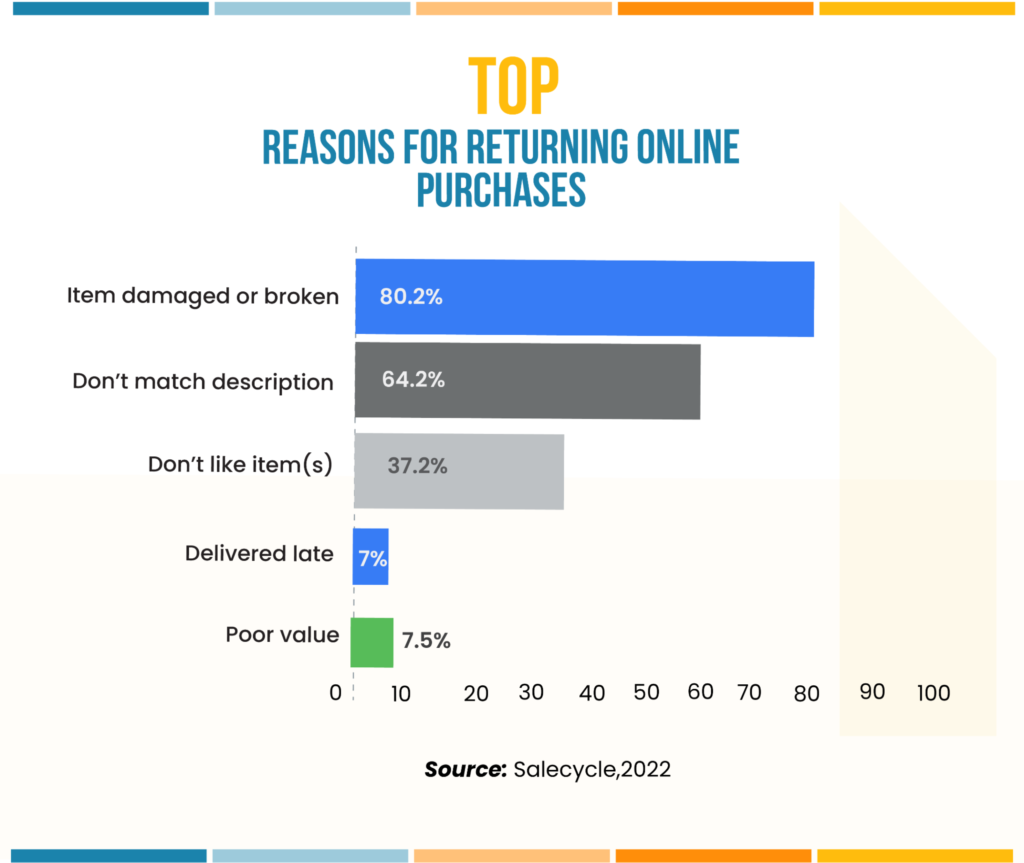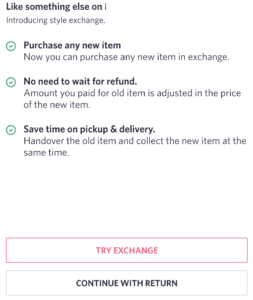Returns are one of the crucial and unavoidable processes in e-commerce, but we can surely learn how to reduce returns in eCommerce.
According to a Shopify study, 42% of e-commerce items were returned last year.
So returns can shoot up your costs and decrease your revenue and profits if not managed properly. Furthermore, returns mess up your ecommerce metrics and increase your team’s workload as well.
In this post, we have mentioned some best ways to reduce returns in ecommerce.
1. A transparent e-commerce returns policy
Having a straight, transparent, and user-friendly return policy is the first step to reducing ecommerce returns and protecting your business from refund scams.
But make sure that your policy is not hard on your customers. That’s because over half of online shoppers reportedly avoid buying from retailers with a rigid and strict returns policy.
Writing your store’s returns policy in order to reduce returns in eCommerce
A returns policy depends on the type of ecommerce business, industry, and the products sold.
Here are 5 key factors that you should while writing the returns policy of your store:
-
- Returns charges: Decide whether you can offer free returns or charge a fee for returns.
- Returns options: Do you only offer returns or exchanges as well?
- Time limit: Decide on a time limit for limit. It can be one week or 10 days or one month depending on your products and niche. Check what time limit your competitors are offering.
- Terms and guidelines: Mention the guidelines and requirements clearly. For example, products must be unused and packed in the original packet.
- Outline Process: Write an easy step-by-step process to return the products.
Also, keep in mind that your customers should be able to easily understand how to return/exchange a product.
2. Analyze why your products are returned
This is a personalized and great practice to reduce returns for your ecommerce store.
You might get surprised to know that a large proportion (64%) of shoppers return because the products “do not match descriptions.”
As per a study by SaleCycle, here are the top 5 reasons for ecommerce returns:

So must ask your customers why they are returning a product. Then, check your ecommerce return metrics to know the top reasons for returning purchases and work on fixing those issues. This practice is not only essential to manage returns but is vital to successfully run your store.
3. Offer instant store credits as a refund option
It is good if you offer refunds back to the source of payment but it is great if you offer store credits as refunds.
That’s because a shopper might not buy again from your store after a bad purchase experience if you refund the original payment source.
On the other hand, by offering instant store credits, you can:
- Retain your customers
- Protect your revenue generated
- Save transaction costs
- Satisfy customers with instant refunds
Pro tip: Only provide store credits as refunds along with an option to transfer store credits to a bank account. This policy will help you save revenue and retain your customers without making your returns policy strict.

4. Ensure safe packing and shipping to reduce returns in eCommerce
Data suggests that “Item damaged or broken” is the top reason for returns in ecommerce. According to the SaleCycle study, a significant proportion (82%) of shoppers opt to return because they receive products in a broken or damaged state.
So make sure that your packing process is secure and safe.
Here are a few tips to ensure safe packing:
- Use the correct packet size so the products don’t jolt around in transit.
- Use safety materials like cardboard boxes and bubble wrap for easy-to-break products.
- Add caution labels on the packet. For example, add a ‘FRAGILE’ label for breakable items like glass.
- Inspect every item before it’s packed and dispatched to customers. This will also help you investigate and prevent refund fraud.
- Seal the packages properly and ask your customers to reject tempered packages at the time of delivery.
If your customers still receive damaged products often, something is going wrong in transit. Ask your logistics partner to ensure safety or it’s time to change your logistics partner.
5. Encourage customers to exchange instead of return
Exchanges are undoubtedly a great way to save ecommerce average revenue and profit at the cost of extra shipping.
But providing exchanges is not enough to reduce returns, you need to encourage exchanges!
One way to uplift exchanges is to have a flexible and user-friendly exchange policy. Here’s an example of a good exchange policy:

In the above exchange policy, customers can not only exchange product size or color, but they can exchange the ordered product with any other product.
Another way to encourage exchanges is to incentivize customers when they opt for an exchange instead of a return. You can entice them with discount coupons, gift vouchers, freebies, etc.
6. Automate returns/exchanges
Returns are mostly created due to a set of similar reasons and do not require your personalized attention, and can be automated.
Returns automation can help you save time that you spent accepting and rejecting every return request manually. You can invest that saved time and effort to measure and analyze returns metrics and take actions to reduce the return rate.
To automate ecommerce returns, you can use a good tool like Helplama Helpdesk, an ecommerce helpdesk software that allows you to empower your customers with a self-service portal that they can use to track orders, modify orders, create return/exchange requests, and more.
Moreover, it can automatically scan your store orders for delivery delays, allowing you to provide proactive customer support. You can try Helplama Helpdesk free for 15 days.
Bottom Line to Reduce Returns In Ecommerce
Indeed returns are inevitable, but they can be managed and reduced. Your store’s returns policy plays a vital role in reducing returns. Make sure that your returns policy is transparent, user-friendly, and can be easily found on your product and other relevant web pages.
Furthermore, regularly track your return rate, identify the common reasons behind the returns, and work on fixing them. And definitely implement the strategies mentioned in this post if you’re not using them already.
If you still feel confused, try the Koala Inspector to reveal the secrets of your competing Shopify stores in one click and know what is working for them.







